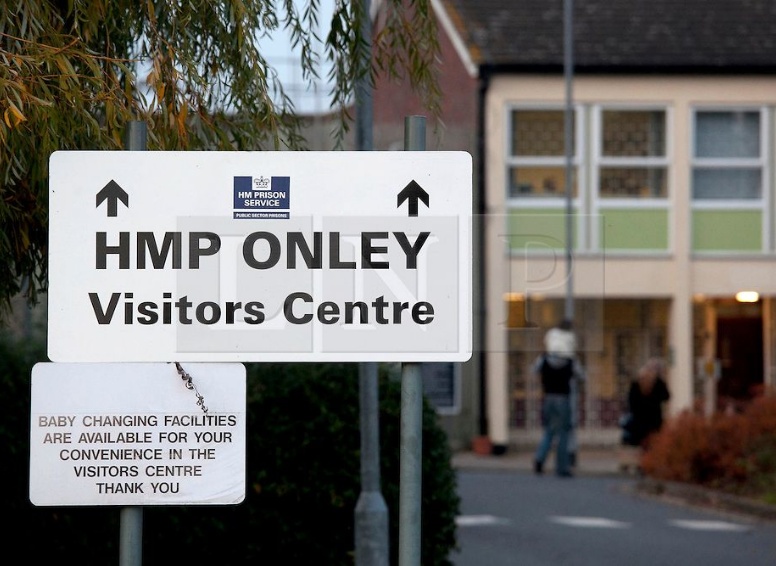SGGS Students Go To Prison...

On a very wet and windy May morning, twelve Year 13 Psychology students headed to HMP Onley with Mrs Whorlow and Mr Mahony for what would be a fascinating and eye-opening day. We asked the students to give us a review...
When we arrived at HMP Onley, we were met by S.O King and S.O. Walls. Our photo ID was checked and we were issued with lanyards to wear whilst inside the prison. We then went into a small security room through contained sliding doors, where we had to empty our bags and pockets - this was to check we didn’t bring any harmful or illegal objects into the prison. With security checks complete, we went through locked doors and then the gates to the Visits Hall.
The Visits Hall seemed bright and colourful in contrast to the rest of the surroundings. A desk near the entrance allows a prison officer to monitor the visitors who came in and out, and clusters of chairs were spaced out across the room so that prisoners can sit opposite their families. There was also a children’s soft play area along one wall to accommodate visits from younger members of the family. Although the Visits Hall allows interaction with their family, prisoners are still closely monitored, and inappropriate behaviour is prevented and stopped at the earliest opportunity. We were informed that visits last one hour, although this can be reconsidered and changed depending on an inmate’s behaviour, in which case they could be upgraded to an enhanced visit (which is two hours) or visiting rights can be restricted. If closer monitoring is needed then prisoners are given a 'closed-visit' with their family. Closed visits allow much less contact and inmates are separated from their family by a glass screen. The feel of this room was much less family-friendly.
Following this we headed to Reception where we were shown the holding cells where prisoners are kept upon admission to the prison, and where they undergo their initial search before entering the prison to ensure they are not carrying any contraband. These searches have to be conducted by a male guard. While in this room we were shown the different handcuffs and restraints used by the prison officers when transporting prisoners. We were then shown around the ‘prop store’, a large store room where the prisoners’ property is placed while they are incarcerated, before we moved on for a tour around the wings.
We visited three wings, the first being I Wing. This was far more as we thought prison wings would be. It had three floors with netting between each floor and a pool table on the ground floor which could be used in association time. The netting prevented prisoners from jumping or throwing rubbish down. The privileges between the wings varied, a prisoner kindly allowed us into his cell in the H wing; this included a television and cut-outs from magazines on the walls. The prison deals with many incidents in the wings, the most common included setting the cell on fire, barricading themselves in and drug/phone smuggling. These incidents result in privileges being removed. With the use of drones, we were informed, it has become harder to stop the exchange of spice and phones. We also visited D Wing, which had corridors on either side, prisoners were in their cells, and despite the odd calling and banging from the cells they were genuinely well behaved.
Out in the pouring rain we headed for the workshops, the first of which has been provided by Halfords. This was a workshop where prisoners learn about all types of bikes, how they work and how to fix them. We had a talk from John Walters, who ran the workshop; he has a zero tolerance policy, so will not accept any bad behaviour from any prisoners whilst in the workshop. He is keen to teach them how to behave sensibly and with good etiquette, which will give them good employability skills for the future. The more experienced prisoners who have spent time in the workshop, are given returned bikes from Halford to fix, which are then given to underprivileged children from deprived areas. We also saw workshops to train prisoners in painting and decorating, bricklaying and other areas of employment.
There are many outside agencies involved in HMP Onley and we went on to meet the social worker – Barry Whorlow. He talked us through the ways in which he supports and assists the prisoners’ in maintaining contact with families (if deemed safe to do so) by promoting continued relationships outside of the prison and encouraging them to change their behaviour, focusing on how their sentence and offending behaviour can affect their children’s long term development and status within a community. He is also makes sure prisoners’ rights are met in terms of custody if it is in the child’s best interest, and family members outside of prison are safe from potentially dangerous or controlling prisoners. It showed us that there is so much more to consider when a person is sentenced.
Following the completion of a prisoner’s sentence, each individual should be prepared for release so we visited the Resettlement team. Gemma Glass spoke to us about how they deal with the prisoners in the weeks prior to their release. Due to the vast majority of prisoners at HMP Onley being from London, they have to arrange transport for them to return to London, and this is usually through train warrants or, if the prisoner was deemed as ‘vulnerable’, extra help is provided for them, particularly if they do not have the support of family or friends. She also spoke of how important it is to develop relationships with the prisoners, as 10% of them are left homeless upon release, but if prisoners have some form of shelter on release they are less likely to reoffend.
The wings and other facilities feed off an enormous main corridor and we saw from here the gym, chapel and healthcare area. The gym is well equipped and it was interesting to hear that they rarely have problems in the gym as individuals do not want this privilege removed. The chapel was being used during our visit for staff training and a member of the Intervention team took time out to tell us about the programmes offered targeting different issues such as, domestic violence, alcohol related crime and aggression management.
We then were privileged enough to be afforded time with the Deputy Governor, Governor Evans. He gave us an incredibly informative talk about the prison system and all the different categories of prisons, telling us (to our surprise) that there are Category D (Open) prisons where there are no fences or walls! We also were told about the logistics of how defendants get from the police station to the courts and to the prison, and how some people do not have a set date for how long they can be held on remand before their court date.
Having seen so much of the prison community, we then headed back to Reception to sign out and hand in our visitors badges. We then walked over to the Visitors’ Centre which is detached from the prison itself in a separate building without the security measures. There were books, a cafe and children’s play area. The purpose of this building is that family and friends can wait if they arrive before visiting time as many have to travel great distances. We ate lunch with S.O. King and had a chance to ask a few questions. We discussed makeshift weapons (eg. toilet brush with razors in the brush head) and riots. Certain officers are trained in riot response, and could be called away to assist in other prisons such as Birmingham last year. S.O. King showed us standard equipment including baton, handcuffs and a fish knife.
Our last session involved observing guards training on how to control and restrain prisoners in a safe way in order to ensure compliance. We were shown different drills and restraints which illustrated the necessary force officers need to use in certain situations. We then were shown role play situations in a demonstration cell. One of the officers acted as the violent or non-compliant prisoner while three others used appropriate force and techniques to regain control. One scenario was the removal of an illegal mobile phone from the “prisoner” and another from a highly aggressive and abusive “inmate”. Restraint involved one officer holding the head whilst the other two locked down the arms.
It was a hugely informative and useful day, and we are grateful fo the staff who made the trip possible.


